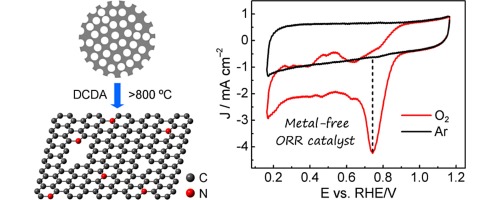Abstract: The development of graphene-based electrocatalyst for the oxygen reduction reaction (ORR) is of great significance. Herein, we report a swelling-induced approach based on the thermal condensation of dicyandiamide (DCDA) to convert the porous sucrose-derived sphere (PSS) into nitrogen-doped graphene (NG) via facile one-step pyrolysis. The polycondensation of DCDA creates the volume expansion that results in the rupture of PSS and the formation of NG after high-temperature nitrogen doping and carbonization processes. This method allows for the facile optimization of the nitrogen doping level and graphitization degree by adjusting the annealing temperature. In alkaline media, the NG exhibits an excellent electrocatalytic ORR activity comparable to commercial Pt/C catalyst in terms of four-electron transfer pathway, low overpotential and high kinetic-limiting current density of 15.29 mA cm(-2) at 0.665 V (vs. RHE), together with its better durability. The high ORR performance of NG is attributed to the synergetic effects between optimal nitrogen doping (moderate total nitrogne content with high proportion of graphitic nitrogen) and enhanced electronic conductivity, which offers the highly active and dense centers and facilitates the electron transfer for ORR process, respectively. This finding is useful for producing novel nanocarbon and propelling the application of clean energy systems. (C) 2015 Elsevier Ltd. All rights reserved. Key words: Oxygen reduction reaction; Fuel cells; Swelling; Graphene; Nitrogen doping Published in ELECTROCHIMICA ACTA, 180 29-36; 10.1016/j.electacta.2015.08.079 OCT 20 2015
|
